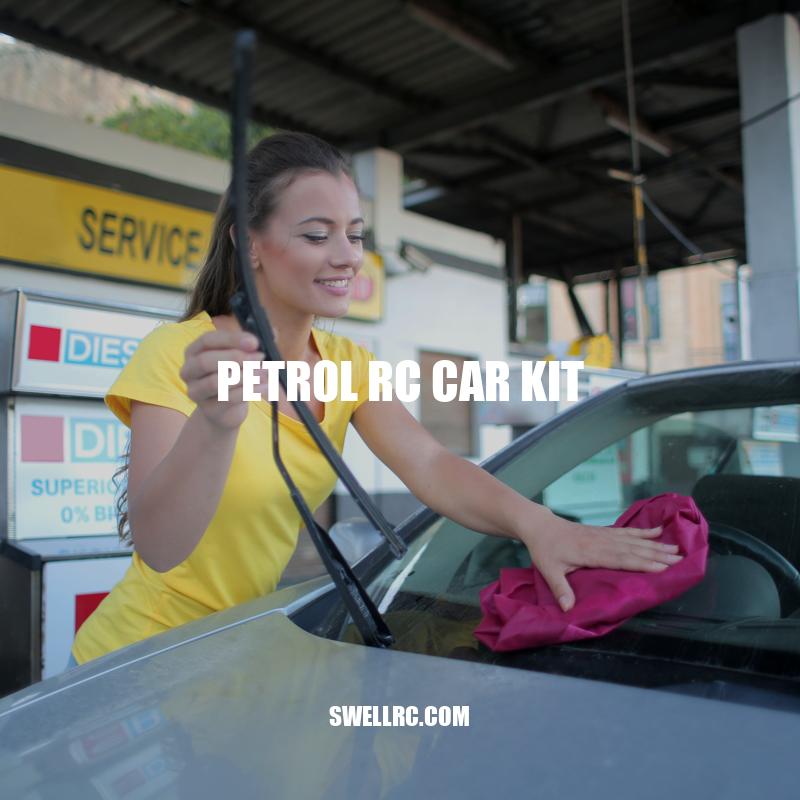Building Your Own Petrol RC Car: A Thrilling DIY Project for Car Enthusiasts
There’s nothing quite like the thrill of racing a high-performance remote-controlled car. And for enthusiasts who are seeking an exhilarating DIY project, a petrol RC car kit can provide just that. These gasoline-powered cars offer impressive speeds and maneuverability, making them immensely popular amongst hobbyists. However, building a petrol RC car from scratch requires significant mechanical knowledge and a willingness to learn. Nevertheless, the end result is a unique, personalized vehicle that will provide hours of entertainment. In this article, we’ll explore the petrol RC car kit in detail, from the components required for assembly and the tools needed to build one, to safety precautions to keep in mind when operating it. Whether you’re an experienced RC car enthusiast or a beginner, you’ll find plenty of valuable information to help you take on this exciting project. So, let’s dive in and get started!
Components of a petrol RC car kit
Before you begin building your petrol RC car, it’s important to understand the many components that come with the kit. These parts are usually included in the package but can vary depending on the manufacturer’s specifications. Some common components of a petrol RC car kit include:
- Chassis – the foundation of the car, which supports the other parts and provides stability
- Engine – the gasoline-powered device that propels the car forward
- Exhaust – a pipe that directs the engine’s exhaust fumes away from the car
- Drivetrain – a system of gears and axles that transmit power from the engine to the wheels
- Suspension – a set of springs and shock absorbers that reduce vibrations and stabilize the car on rough terrain
- Steering – a mechanism that controls the direction of the car and allows for precision turning
- Wheels and tires – the components that provide traction and allow the car to move
In addition to these components, you’ll also need various tools and supplies to assemble the car, such as screwdrivers, pliers, wrenches, and soldering irons. Fortunately, many websites offer detailed instructions and step-by-step guides on how to build your petrol RC car kit. You can also find reviews and recommendations for kits and supplies, such as the HPI Racing Nitro RS4 3 Drift, Redcat Racing Lightning STR, or Team Losi 8IGHT-T Nitro Truggy. With the right components and tools, you’ll be well on your way to constructing your own high-performance petrol RC car.
What are the basic components of an RC car?
The basic components of an RC car include:
- Chassis: the frame and body of the car.
- Motor: provides power to move the car.
- Battery: supplies power to the motor.
- Radio transmitter: allows the user to control the car.
- Receiver: inside the car, receives signals from the transmitter.
- Servo: moves the wheels and controls steering.
- Wheels and tires: provide traction and movement.
If you’re interested in purchasing an RC car, websites like Horizon Hobby and Tower Hobbies offer a wide range of options for both beginners and experienced hobbyists.
To properly assemble and operate a petrol RC car kit, it’s important to have a basic understanding of how gasoline engines work. Here are some key facts to keep in mind:
- A petrol engine is a type of internal combustion engine that uses gasoline as fuel
- The engine converts the fuel into energy, which is used to power the drivetrain and move the car forward
- In a four-stroke engine, like those used in most petrol RC cars, there are four stages of the combustion cycle: intake, compression, ignition, and exhaust
- The fuel is mixed with air in the carburetor and then ignited by a spark plug during the ignition stage
- You’ll need to use a specific type of gasoline, usually with a high percentage of nitromethane, to power your petrol RC car
In addition to these technical details, many websites offer helpful tips and tricks for building and operating your petrol RC car kit. For example, you may need to adjust the engine’s tuning to optimize its performance, or choose the right kind of tires and suspension for the terrain you’ll be driving on. Some popular websites for RC car enthusiasts include RC Universe, RC Driver, and RC Car Action. Whether you’re a seasoned hobbyist or a curious beginner, there’s always something new to discover and learn about the exciting world of petrol RC car kits.
| Pros | Cons |
|---|---|
| High speeds and performance | Requires technical knowledge and skills |
| Fuel-powered | Can be noisy and produce exhaust fumes |
| Customizable with various body kits and accessories | May require regular maintenance and repairs |
What type of engine is petrol engine?
A petrol engine, also known as a gasoline engine, is a type of internal combustion engine that uses petrol as its fuel. It works by compressing a mixture of air and petrol, then igniting it with a spark plug, which creates a controlled explosion to generate power. Petrol engines are commonly found in cars, motorcycles, and small aircraft. If you want to learn more about petrol engines, you can find information on various online sources like HowStuffWorks, Car and Driver, and MotorTrend. Additionally, if you’re looking for products related to petrol engines, you may consider checking out websites like Amazon or eBay, where you can find a range of products such as engine oils, spark plugs, fuel additives, and more.
Staying Safe with Petrol RC Car Kits
While building and operating a petrol RC car kit can be a fun and exciting hobby, it’s important to prioritize safety at all times. Here are some essential tips to keep in mind:
- Operate your petrol RC car kit in a spacious, well-ventilated area to avoid inhaling exhaust fumes or causing a fire
- Wear protective gear such as gloves, goggles, and a face mask when handling fuel or other engine components
- Always use the recommended type of fuel and oil for your car, and store them in a cool, dry place away from heat sources or flames
- Be mindful of other people and vehicles in the area when driving your car, and avoid driving near busy streets or intersections
- Inspect your car and its components regularly for signs of wear or damage, and make repairs as needed
- Follow any additional safety guidelines or recommendations provided by the manufacturer or other experts in the hobby
In addition to these general safety tips, there are also specific products and accessories that can help ensure a safer and smoother experience with petrol RC car kits. For example, you may want to invest in:
- Fireproof safety bags for storing fuel and other flammable liquids
- A fuel pump or syringe for easy and precise refueling without spills
- Shock absorbers and other suspension components to improve handling and stability
- A rechargeable battery pack for the car’s electronics, so you don’t have to constantly replace batteries
Several websites and online forums also offer helpful advice and resources for staying safe with petrol RC car kits. For example, RC Driver has a series of videos on safety and maintenance tips, while RC Car Tips provides detailed guides on topics such as fuel tuning and engine break-in procedures. By following these guidelines and staying informed about the latest safety products and techniques, you can enjoy the thrill of racing and building your own petrol RC car kit while minimizing the risks.
What are the risks of RC cars?
RC cars can be a fun hobby, but they also come with some risks that should be considered:
| Risks: |
|---|
| Driving too fast or recklessly can result in crashes and damage to the car. |
| Improper charging or use of batteries can cause fires or explosions. |
| Small parts on the car, such as wheels or antennas, can be a choking hazard for young children. |
| In some cases, interference from other devices or radio signals can cause the car to malfunction or lose control. |
It’s important to always follow proper safety guidelines and manufacturer instructions when using RC cars. Additionally, some websites or products may offer additional safety features or tips for safe use.
Customizing your petrol RC car kit
One of the great things about building a petrol RC car kit is that you have a wide range of options for customizing its appearance and performance. Here are some ideas for modifying your car’s looks and capabilities:
- Swap out the car’s body shell with a different design or color scheme
- Upgrade the car’s wheels and tires for better traction and stability
- Add LED lights or other embellishments to the car’s chassis or body
- Install a louder exhaust or engine muffler for a more realistic sound
- Upgrade the car’s engine or other components for faster acceleration and top speed
Of course, when making any modifications to your petrol RC car kit, it’s important to consider how each change may affect its overall performance and safety. You may want to do some research on specific products or upgrades before making a purchase, or consult with experts in the hobby for advice.
There are also several online stores and marketplaces that specialize in selling petrol RC car kit accessories and customization options. For example, HobbyKing offers a wide range of parts and kits for building and modifying RC cars, while HPI Racing specializes in high-performance engines and other components. You can also find many community forums and social media groups dedicated to RC car enthusiasts, where you can share tips and ideas with others who share your passion.
By taking the time to customize your petrol RC car kit according to your preferences, you’ll be able to create a unique and personalized vehicle that reflects your style and enthusiasm for the hobby.
What’s better petrol or electric RC cars?
Petrol and electric RC cars each have their advantages and disadvantages. Here are some factors to consider:
Petrol RC Cars | Electric RC Cars
—————|——————
– Usually faster and more powerful | – Quieter and cleaner
– Can be more durable and run for longer periods of time | – Typically lower maintenance and easier to operate
– More expensive to run due to petrol costs | – Generally more affordable and environmentally friendly
– Require regular maintenance and tuning | – Batteries need to be recharged
Ultimately, the choice between petrol and electric RC cars depends on personal preference and intended use.
For more information on RC cars, you may visit websites such as hobbytron.com, rcplanet.com or amainhobbies.com, where you can find a wide range of products and resources to help you make an informed decision.
Maintaining your petrol RC car kit is essential to keep it running smoothly and reliably. Regular maintenance and replacement of worn-out parts are critical to keep your car in top condition. Here are some key things to keep in mind:
- Change the oil regularly, following the manufacturer’s recommended schedule
- Clean the air filter and change it periodically as needed
- Check the spark plug and replace it if it’s worn or dirty
- Inspect the drivetrain, suspension, and other components for wear and tear, and replace parts as needed
- Keep the chassis clean and free of debris, which can cause damage to the car’s engine and other components
Performing regular maintenance can help extend the life of your petrol RC car kit and prevent more costly repairs down the line. Storing your kit properly is also essential. It should be kept in a dry and cool location away from direct sunlight and other hazards.
Many online stores and hobby shops, such as Tower Hobbies and AMain Hobbies, offer a wide variety of parts and products for maintaining and repairing petrol RC car kits. You can also find many online tutorials and instructional videos on servicing and repairing your kit, which can be a great resource for learning more about the hobby and keeping your car in top condition.
With proper maintenance and care, your petrol RC car kit will continue to provide hours of high-speed thrills and excitement for years to come.
How can I make my RC car faster with petrol?
To make your RC car faster with petrol, you can follow these tips:
- Upgrade your RC car’s engine to a more powerful one.
- Invest in high-performance tires to improve grip and acceleration.
- Replace the standard air filter with an aftermarket one to increase airflow and improve performance.
- Install a tuned exhaust system to increase power and improve fuel efficiency.
You may find websites like Hobbypartz.com and Rovanrc.com helpful for finding upgrade parts and accessories for your RC car. However, keep in mind that modifying your RC car may void its warranty and could result in damage or injury if not done properly. Always follow manufacturer guidelines and safety precautions.
In conclusion
Building and racing a petrol RC car can be a thrilling and rewarding hobby for enthusiasts who love tinkering with engines and pushing their cars to the limit. While these cars require some technical knowledge and care, they offer unparalleled speed and performance that can provide hours of fun and excitement.
Whether you’re a seasoned hobbyist or a newcomer to the world of RC cars, a petrol RC car kit is a great choice for anyone looking for a challenging and engaging project. With some patience and attention to detail, you can build a powerful and competitive car that will turn heads at the track.
So if you’re ready to dive into the world of RC car racing and explore the possibilities of petrol-powered engines, be sure to do your research, follow safety precautions, and enjoy the ride!



